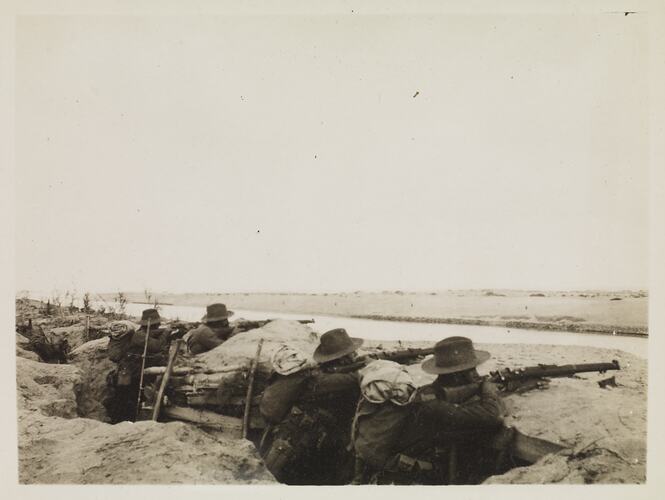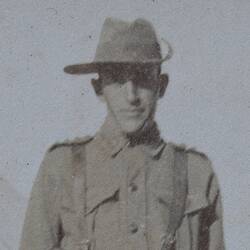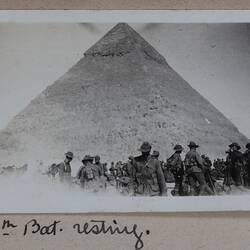Summary
One of 108 images in an album from World War I likely to have been taken by Captain Edward Albert McKenna. The album contains photographs of the 7th Battalion in Egypt.
Image of a statue depicting some of the men in the trenches near the Serapeum. The Serapeum (or 'Sarapeion') was a temple built in Ptolemaic Alexandria to honour the Greco-Egyptian god Serapis, a hybrid of the Egyptian gods Osiris and Apis.
The album relates to the service of Captain Edward Albert McKenna. McKenna, born in Castlemaine, Victoria, was a 36-year-old department manager of soft goods when he enlisted on 17 August 1914. He lived at 5 St James Buildings, William Street, Melbourne, and had been married to Elizabeth ('Lillie') Mary McKenna since 1910. He embarked from Melbourne 19 October 1914 on the HMAT Hororata, and served in the 7th Battalion Australian Infantry.
He was killed in action in Gallipoli around 25-30 April 1915, aged 37. His kit bag was unusually full, even containing seven shirts, a pillow, six towels, a travelling rug, gumboots, and pyjamas and slippers. Also amongst his possessions was a camera, although no photographic prints or albums.
He was buried at 7 Lone Pine Cemetery, Gallipoli. His details appear on the honours roll on the web page of the Australian War Memorial.
Description of Content
Four Australian soldiers in a trench up to their shoulders, aiming guns at an unknown target across the other side of the river. Each of the men are wearing packs and hats. The river that separates the soldiers and their target stretches into the distance. The opposite side of the river consists of a flat, sandy landscape.
Physical Description
Black and white photographic print on paper with a white border.
More Information
-
Collection Names
Returned and Services League (RSL) Collection, Military Memorabilia Collection
-
Collecting Areas
-
Acquisition Information
Donation from Mr J. Willis, circa 1986
-
Acknowledgement
Mr. J. Willis
-
Place & Date Depicted
-
Photographer
Captain Edward A. McKenna - Australian Imperial Force (AIF), Egypt, 1914-1915
-
Creator
-
Inscriptions
Hand written in ink on the support underneath the photograph: 'In the Trenches / Serapeum' Hand written in ink on the back of the photograph: 'In the Trenches / Serapeum.'
-
Classification
-
Category
-
Discipline
-
Type of item
-
Image Dimensions - Photograph
108 mm (Width), 84 mm (Height)
-
Image Dimensions - Photograph album page
174 mm (Width), 141 mm (Height)
-
References
National Archives of Australia: McKenna Edward Albert, barcode 1949283, series B2455/1. 'Serapeum, Alexandria,' Sacred Destinations, at: [Link 1] accessed: December 19, 2012
-
Keywords
Military History, World War I, 1914-1918, Trenches, Training, Australian Army


